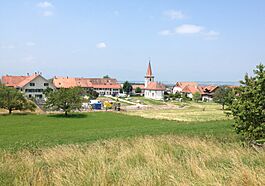Villars-Tiercelin facts for kids
Quick facts for kids
Villars-Tiercelin
|
||
|---|---|---|
 |
||
|
||
| Country | Switzerland | |
| Canton | Vaud | |
| District | Gros-de-Vaud | |
| Area | ||
| • Total | 4.99 km2 (1.93 sq mi) | |
| Elevation | 813 m (2,667 ft) | |
| Population | ||
| • Total | 403 | |
| • Density | 80.76/km2 (209.2/sq mi) | |
| Postal code |
1058
|
|
| Surrounded by | Corcelles-le-Jorat, Dommartin, Froideville, Montaubion-Chardonney, Peney-le-Jorat, Poliez-Pittet | |
Villars-Tiercelin was once a small town, called a municipality, in Switzerland. It was located in the Gros-de-Vaud District in the canton of Vaud.
On July 1, 2011, Villars-Tiercelin joined with four other towns. These towns were Montaubion-Chardonney, Sottens, Villars-Mendraz, and Peney-le-Jorat. Together, they formed a new, larger municipality called Jorat-Menthue.
Contents
Understanding Villars-Tiercelin's Location
Villars-Tiercelin covered an area of about 4.99 square kilometers (about 1.9 square miles). This is roughly the size of 700 football fields!
How Land Was Used
A big part of the land, almost half (45.9%), was used for farming. Another large part (46.5%) was covered by forests. Buildings and roads took up 7.2% of the land. A very small amount was rivers or lakes.
The forests were mostly dense, thick woods. For farming, people grew crops on 30.3% of the land. The rest of the farm land (15.2%) was used for pastures where animals could graze.
Changes in Districts
Before 2006, Villars-Tiercelin was part of the Echallens District. When that district closed, Villars-Tiercelin became part of the new Gros-de-Vaud District.
Villars-Tiercelin's Coat of Arms
A coat of arms is like a special symbol for a town or family. Villars-Tiercelin's coat of arms was divided into two halves. One half was silver (Argent) and the other was red (Gules). Across the middle, there was a wavy line that changed color from red to silver.
People and Population in Villars-Tiercelin
In 2009, about 403 people lived in Villars-Tiercelin. Over ten years (from 1999 to 2009), the number of people grew by 16.8%. This growth happened because more people moved in (9.3%) and more babies were born than people died (8.1%).
Languages Spoken
Most people in Villars-Tiercelin spoke French. In 2000, 93.6% of the people spoke French. A smaller number spoke German (3.5%) or English (0.9%).
Where People Were Born
In 2000, about 21% of the people living in Villars-Tiercelin were born there. Many others (44.6%) were born in the same canton (Vaud). About 19% came from other parts of Switzerland, and 14.9% were born outside of Switzerland.
Age Groups in the Town
In 2009, the population had different age groups:
- Children (0-9 years old): 14.9%
- Teenagers (10-19 years old): 13.9%
- Young adults (20-29 years old): 6.9%
- Adults (30-59 years old): 42.7%
- Seniors (60 years and older): 21.1%
Family Life and Homes
In 2000, there were 149 homes in Villars-Tiercelin. On average, about 2.3 people lived in each home.
- 28.5% of homes had only one person.
- Many homes were married couples, some with children and some without.
- There were also single parents living with their children.
Most of the buildings (62.1%) were single-family homes. There were also multi-family buildings and buildings used for both homes and businesses.
Historical Population Changes
The chart below shows how the number of people living in Villars-Tiercelin changed over many years.

Economy and Jobs
In 2010, the unemployment rate in Villars-Tiercelin was 2.7%. This means only a small number of people who wanted jobs couldn't find them.
Types of Jobs
Jobs are often grouped into three main types:
- Primary sector: These jobs involve getting raw materials from nature. In 2008, 15 people worked in this area, mostly in farming and forestry.
- Secondary sector: These jobs involve making things. 5 people worked here, mainly in manufacturing (making goods) and construction.
- Tertiary sector: These jobs provide services to people. 14 people worked in this sector. Examples include selling cars, moving goods, working in hotels or restaurants, and teaching.
Commuting for Work
Many people who lived in Villars-Tiercelin worked outside the town. In 2000, 152 people traveled to other places for work. Only 16 people came into Villars-Tiercelin to work. Most people (77.4%) used a private car to get to work. A smaller number (5.9%) used public transportation.
Religion in Villars-Tiercelin
Based on information from 2000, people in Villars-Tiercelin followed different religions:
- About 29.4% were Roman Catholic.
- About 49.0% belonged to the Swiss Reformed Church.
- A small number belonged to other Christian churches.
- Some people did not belong to any church.
Weather Patterns
Villars-Tiercelin usually had about 130 days of rain or snow each year. The total amount of rain and snow was about 1372 millimeters (54 inches) per year.
The wettest month was November, with about 129 millimeters (5 inches) of rain or snow. May had the most days with precipitation (13.4 days), but less total rain. April was the driest month.
Education and Schools
Many adults in Villars-Tiercelin had a good education. In 2000, about 42.3% had finished upper secondary education (like high school). Also, 19.2% had gone on to higher education, such as a university.
Local School System
In the 2009/2010 school year, there were 71 students in the Villars-Tiercelin school area.
- The canton (Vaud) offered two years of pre-school, which is not required.
- Primary school lasted for four years, and 34 students were in this program.
- Lower secondary school lasted for six years, with 36 students attending.
- A few students were homeschooled or went to other special schools.
Some students from Villars-Tiercelin went to schools in other towns. Also, a few students from other towns came to school in Villars-Tiercelin.
See also
 In Spanish: Villars-Tiercelin para niños
In Spanish: Villars-Tiercelin para niños




